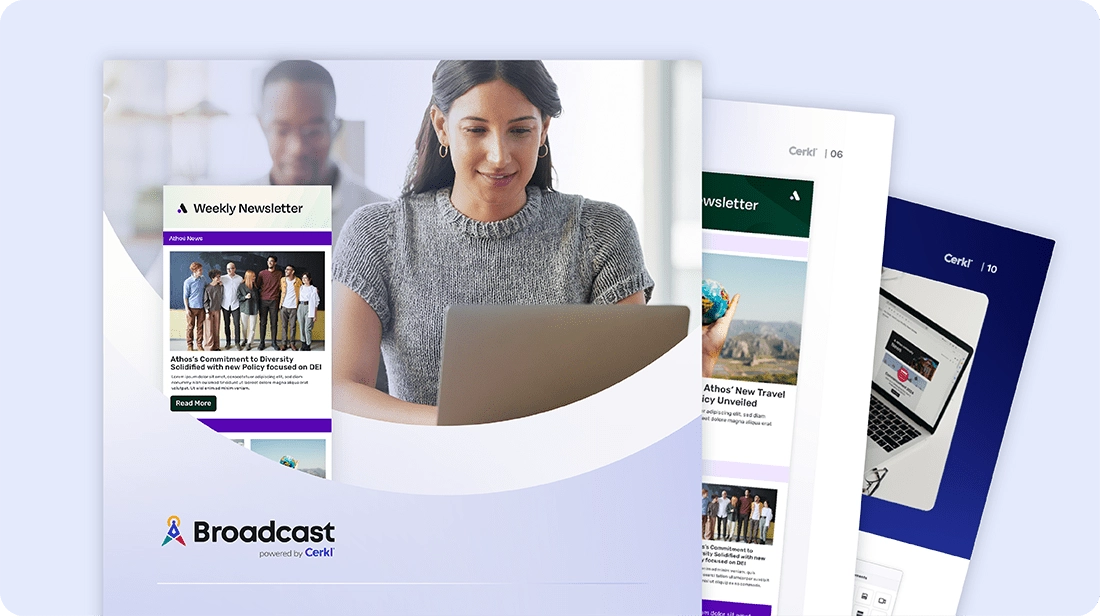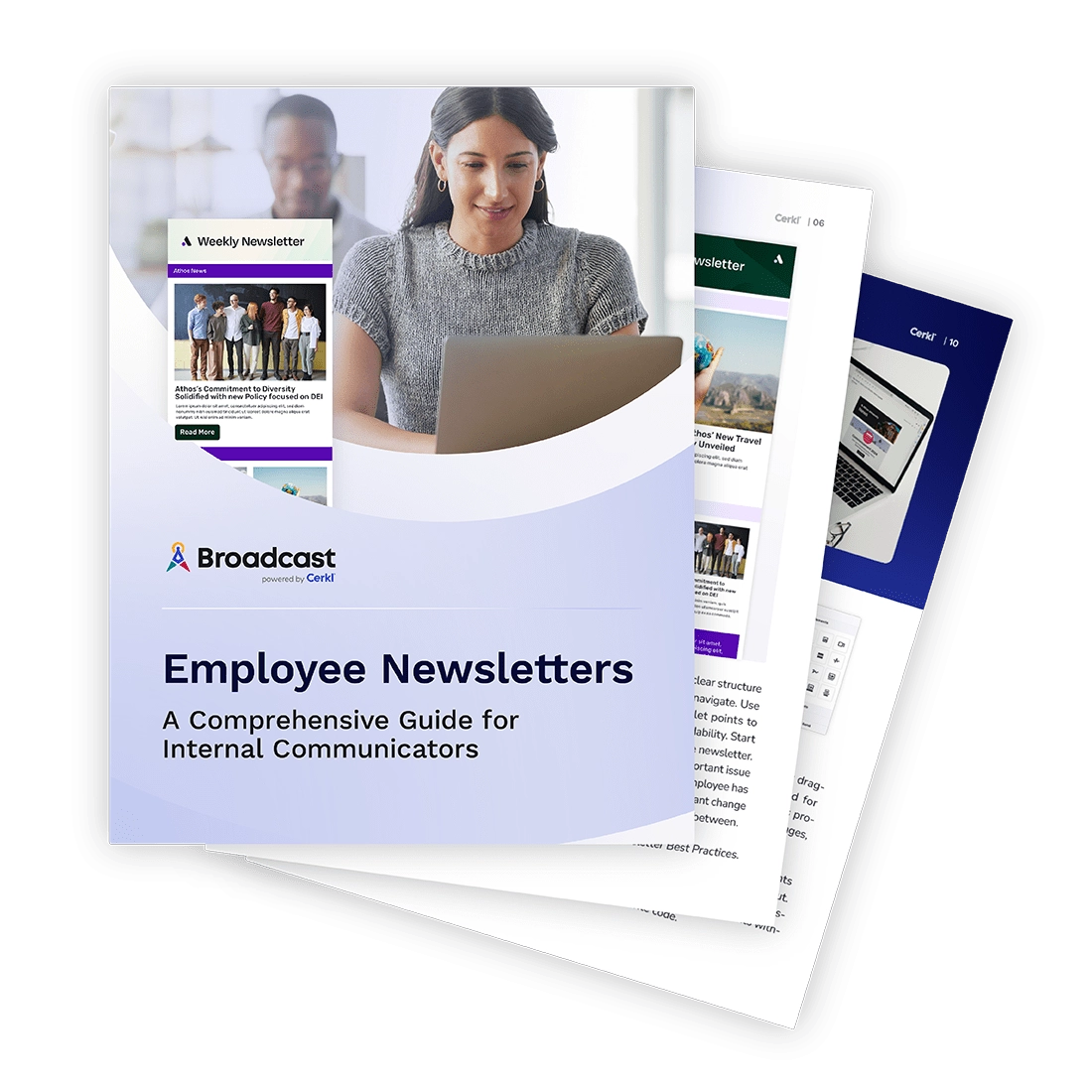Choosing the best time to send an internal newsletter can make all the difference to employee engagement and productivity. Here are some answers to help you get it right.

.webp)
What are the key elements of an engaging employee newsletter? What should not be included in an employee newsletter? Find the answers to those questions and more best practices in our comprehensive guide on creating employee newsletters.
Access NowOptimal timing for employee emails: Discover how precise timing boosts open rates, ensuring internal newsletters are read and acted upon. Research shows that the best time to send employee emails is often on Friday afternoons, particularly between 1 and 3 pm, when open rates tend to peak.
Employee open patterns: Data indicates that employees typically open emails during early mornings or just after lunch, although these trends can vary by industry. Additionally, employee email open rates appear to be highest on specific days and times.
Internal email best practices: The best time to send an internal employee email is during periods of lower inbox congestion, ensuring your message stands out.
Actionable Insights: Gain practical tips to avoid sending newsletters during off-hours or low-activity periods, ensuring your message cuts through the noise and drives employee engagement. Applying these recommendations can significantly boost open rates, enhance information absorption, and improve overall communication effectiveness.
Internal newsletters have massive benefits. They increase employee engagement, improve communication, enhance employee recognition, help to break down silos, and maximize employee retention. They also increase transparency, enable organizations to share knowledge and improve compliance, promote company culture, and increase productivity.

A lot of effort goes into producing a good internal newsletter. If you are involved with internal communications in your organization, some of this effort may well be yours! Have you ever hit the send button on your meticulously crafted newsletter only to be met with radio silence? If so, the chances are that it hasn’t got anything to do with the quality of the content. Rather, it’s got to do with timing. By sending your newsletter when employees are most receptive, you can boost open rates, increase information absorption, and ultimately foster a more connected and informed workforce.
Think about it. In the world of internal communications, your employees are essentially your internal customers. You want to deliver engaging content that they’ll not only see in their inboxes and open, but also read and act upon. When it comes to your company newsletter, timing is everything.
Since employee newsletters are meant to reach a company’s entire workforce, the most common delivery method is via internal email. This ensures everyone has access to the information, regardless of location or department. It also allows for easy tracking of delivery and opens to measure the newsletter’s effectiveness. However, it’s up to internal communicators to ensure that employees see internal newsletters as vital internal updates that they want to open. And if they are sent at the “wrong” time, they may never see the light of day.
This post examines the best and worst times to send your internal newsletter, giving you valuable insights to maximize engagement.
Guidelines for newsletters that will maximize employee commitment

There’s no one-size-fits-all answer to the “best” time for internal newsletters. However, research and industry analysis offer compelling insights that don’t necessarily match commonly touted answers. Also, it’s true that best and worst times vary for different industries.

Because organizations vary so much, it’s advisable to try a data-driven approach by analyzing your company’s internal email traffic patterns. Are there specific days or times when emails gain more traction? Another good idea is to A/B test different sending times to see what resonates best with your audience. Once you’ve done your research, you can make some vital internal updates.
Even if you can’t pinpoint the very best time, it’s essential to take steps to avoid the worst possible times. Here’s what our research reveals you should avoid.
The Employers Council urges managers to stop sending emails after hours. They point out that sending emails during off-hours can inadvertently pressure colleagues to respond promptly, disrupting their personal time and potentially leading to burnout. To maintain a healthy work-life balance, it's advisable to draft emails during non-working hours but schedule them to be sent during the next business day. This approach ensures that communication remains timely without encroaching on personal time. Additionally, fostering a workplace culture that respects personal boundaries and clearly communicates expectations regarding after-hours communication can further support employee well-being.
“Managers who send emails to employees when something occurs to them so they won’t forget to let the employee know are likely aggravating these employees. This is because employees often feel compelled to respond even after work hours. Managers may assume that the employee won’t read the email until they begin work, but the emails pop up on their cellphones just like they do on the manager’s phone.”
Employers Council
The jury’s still out on a definitive “best day.” Research suggests both midweek (Tuesday-Thursday) and Friday can be effective.

Some days are good to send your newsletter via internal email, but others are not. Indications are that you should avoid Mondays and Saturdays.
While there’s limited research specifically analyzing the best times to send internal newsletters across different industries, we can explore some general insights and how they might apply to each sector:
Here are internal communications tips for sending your newsletters to employees.
Guidelines for newsletters that will maximize employee commitment

By sending your newsletter at the optimal time for individual employees, you significantly increase the chances of it being seen and acted upon. Here’s why timing is crucial.
Ultimately, the best time and day for your internal employee newsletter depends on a variety of factors. By analyzing industry research, considering your company culture, and testing different times, you can find the sweet spot for maximum employee engagement. Remember, the goal is to deliver valuable content when your employees are most receptive.

Designed for internal communicators, Cerkl Broadcast serves as a centralized hub for all communication assets. It enables you to segment your audience and allow employees to choose their preferences and categories. The software does the rest, tracking when each employee engages in their internal newsletter. In this way, it curates the best time and day to send each employee personalized newsletters.
In this way, Broadcast improves efficiency, and targeting, and saves communicators time.
Even before you consider the best time to send an employee newsletter, you need to focus on creating killer internal newsletters. Our Cerkl Broadcast guide, Employee Newsletters: A Comprehensive Guide for Internal Communicators is designed to provide you with all the answers. It discusses how newsletters have changed over the decades and why they still matter. We cover the various formats you can use for internal employee newsletters as well as design options. It’s vital to know the best practices for internal newsletters. You’ll find guidelines right here along with delivery options and guidance on the length and frequency of internal newsletters.

Guidelines for newsletters that will maximize employee commitment
What is the best time of day to send newsletters? Friday (1-3 pm) or Midweek (Tuesday-Thursday). According to some research, Friday offers a higher open rate (63%) compared to midweek (around 58%)
What is the average open rate for internal newsletters? Varies by industry and day, but generally ranges from 55% to 89%
Is Friday a good day to send a newsletter? It can be a good day, especially Friday afternoons (1-3 pm) due to higher open rates (around 66%).

Guidelines for newsletters that will maximize employee commitment